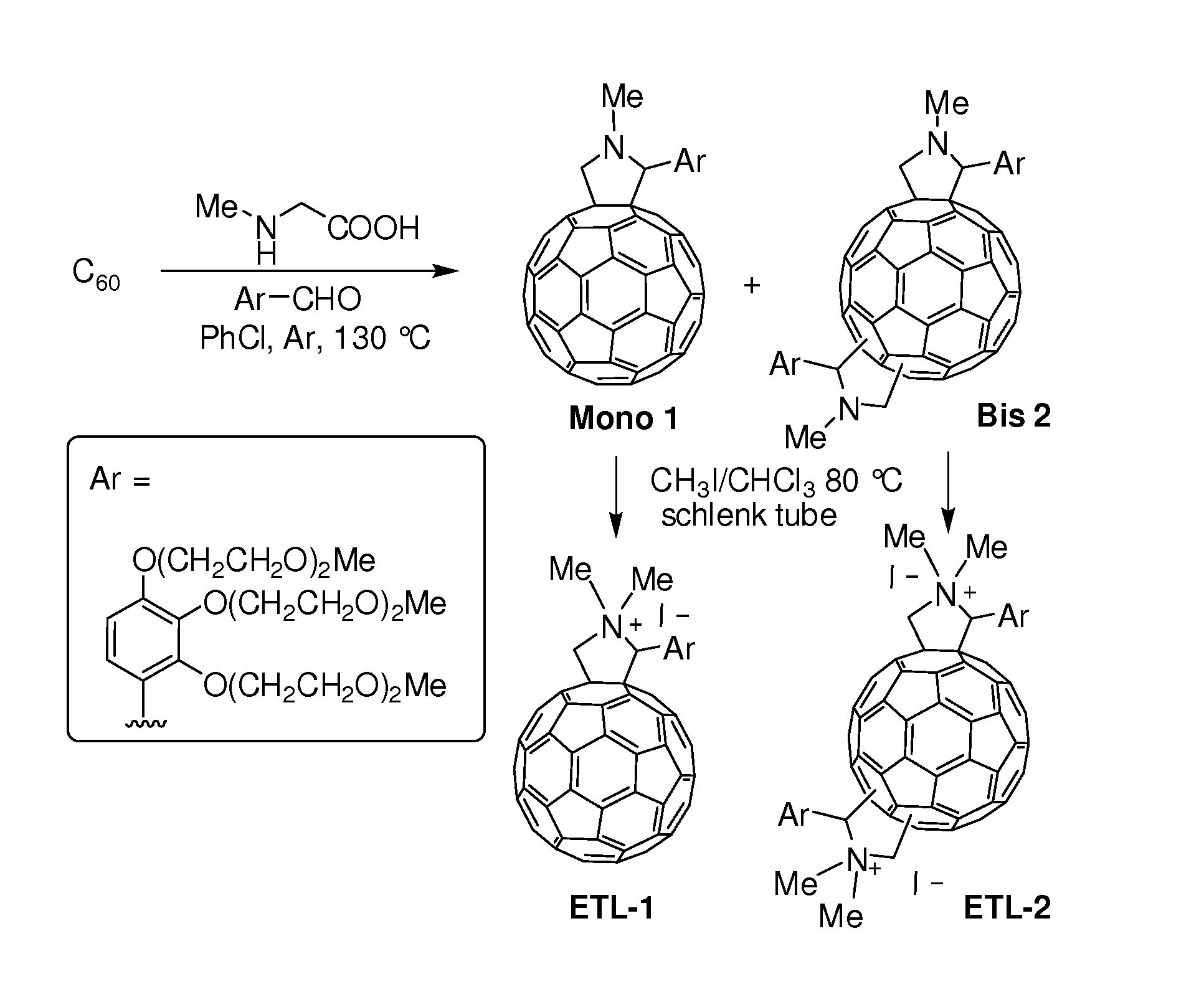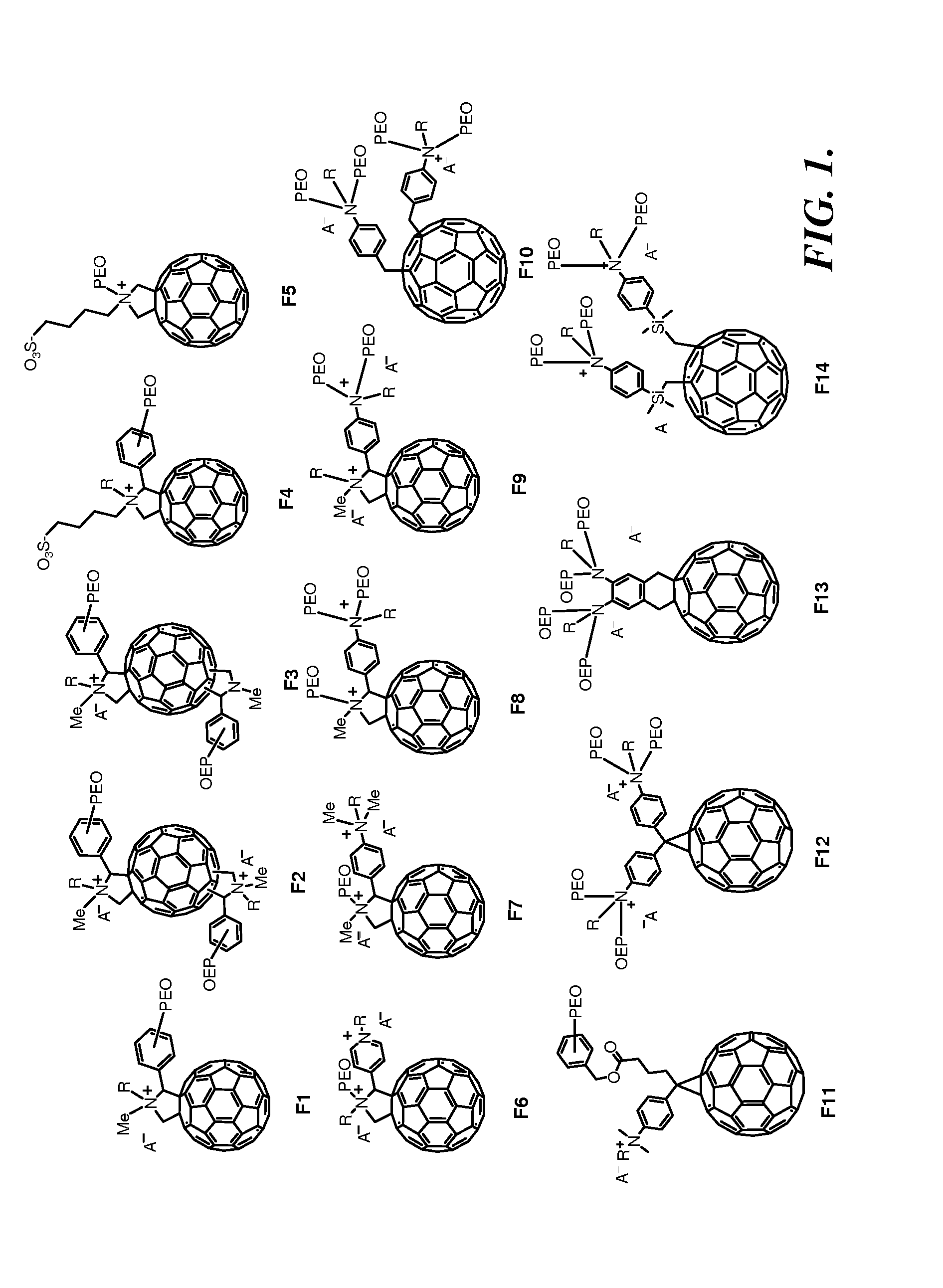Fullerene surfactants and their use in polymer solar cells
a technology of surfactants and solar cells, applied in the field of fulllerene surfactants and their use in polymer solar cells, can solve the problems of affecting the use of practical applications, affecting the performance of ag-based devices, and lowering vsub>oc /sub>and device performance, so as to achieve the effect of enhancing solar cell efficiency
- Summary
- Abstract
- Description
- Claims
- Application Information
AI Technical Summary
Benefits of technology
Problems solved by technology
Method used
Image
Examples
example 1
The Preparation, Characterization, and Use of Representative Fullerene Surfactants: ETL-1 and ETL-2
[0088]In this example, the preparation, characterization, and use of representative fullerene surfactants, ETL-1 and ETL-2, is described. The fabrication and characterization of devices that include the surfactants is also described.
[0089]All reactions dealing with air- or moisture-sensitive compounds were carried out using standard Schlenk technique. All 1H (500 MHz) and 13C (125 MHz) spectra were recorded on Bruker AV500 spectrometers. Spectra were reported in parts per million from internal tetramethylsilane (δ0.00 ppm) or residual protons of the deuterated solvent for 1H NMR and from solvent carbon (e.g., δ77.00 ppm for chloroform) for 13C NMR. The matrix for MALDI-TOF-MS used 2:1 mixture of alpha-cyano-4-hydroxycinnamic acid (CHCA) / 2,5-dihydroxybenzoic acid (DHB) in acetonitrile. Elemental analyses were performed by QTI, Whitehouse, N.J. (www.qtionline.com). AFM images under tappi...
example 2
The Preparation and Characterization of Representative Photovoltaic Devices with Fullerene Surfactant-Containing Interfacial Layer
[0106]In this example, the preparation and characterization of representative photovoltaic devices with a fullerene surfactant-containing layer intermediate the active layer and cathode is described.
[0107]Fabrication of Photovoltaic Devices
[0108]ITO-coated glass substrates (15 Ω sq−1) were cleaned sequentially by sonication in detergent and deionized water, acetone and isopropanol. After drying under a N2 stream, substrates were air-plasma treated for 30 s. A about 35 nm layer of PEDOT:PSS (Baytron® P VP Al 4083, filtered through a 0.45 μm nylon filter) was spin-coated onto the clean substrates at 5 kRPM and annealed at 140° C. for 10 min. The substrates were transferred to a N2-filled glovebox where a homogeneously blended solution of PIDTPhanQ:PC71BM (40 mg / ml in o-dichlorobenzene stirred overnight in glovebox, 1:3 polymer:fullerene by weight) was spin-...
PUM
| Property | Measurement | Unit |
|---|---|---|
| Efficiency | aaaaa | aaaaa |
| Hydrophilicity | aaaaa | aaaaa |
| Transport properties | aaaaa | aaaaa |
Abstract
Description
Claims
Application Information
 Login to View More
Login to View More - R&D
- Intellectual Property
- Life Sciences
- Materials
- Tech Scout
- Unparalleled Data Quality
- Higher Quality Content
- 60% Fewer Hallucinations
Browse by: Latest US Patents, China's latest patents, Technical Efficacy Thesaurus, Application Domain, Technology Topic, Popular Technical Reports.
© 2025 PatSnap. All rights reserved.Legal|Privacy policy|Modern Slavery Act Transparency Statement|Sitemap|About US| Contact US: help@patsnap.com



